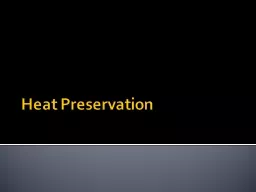

Cooking is the transfer of heat energy from some source to the food Top 3 ways to heat in kitchen stovetop conventional oven microwave oven Different methods of heat transfer Conduction Heat transferred through direct contact ID: 784097
Download The PPT/PDF document "Heat Preservation Introduction" is the property of its rightful owner. Permission is granted to download and print the materials on this web site for personal, non-commercial use only, and to display it on your personal computer provided you do not modify the materials and that you retain all copyright notices contained in the materials. By downloading content from our website, you accept the terms of this agreement.
Slide1
Heat Preservation
Slide2Introduction
Cooking is the transfer of heat energy from some source to the food
Top 3 ways to heat in kitchen
stovetop
conventional oven
microwave oven
Different methods of heat transfer
Slide3Conduction
Heat transferred through direct contact
Only the flat surface of the pan is hot enough to cook anything
Pans are made of metals - conduct heat efficiently & do not melt on the stovetop
Requires less time
Slide4Convection
Heat transfer through a fluid
Liquid or gas
Oven is a confined area that gets hot by flames or electric coils
Cooks the food from all directions
Ovens heat foods from the outside in
Requires more time
Slide5Radiation
Transfer of heat using electromagnetic radiation
Microwave oven
Slide6Microwave Oven – History
http://www.ideafinder.com/history/inventions/microwave.htm
Slide7Microwave Oven
Microwave ovens work by spinning water, fats, sugars & oils inside food
Causes friction, which then heats the food & cooks it from the inside
Fastest method
Slide8Microwave
Acceptable
dishes for the microwave:
Paper, plastic, glass, microwaveable
dishes
Unacceptable
dishes for the microwave:
Metal, dishes
with gold or silver on
them
Cooking Tips – see handout
Slide9In Review
http://www.wisc-online.com/Objects/ViewObject.aspx?ID=SCE304
Slide10Degrees of Preservation & Thermal Death Curves
Slide11Heating Foods
Kills some microorganisms, destroys most enzymes & improves shelf life
Does not preserve a food indefinitely
Creates 4 degrees of preservation – depending on product
Sterilization
Commercial Sterility
Pasteurization
Blanching
Slide12Overview of Heat Treatments
Comparisons
Mild
Severe
Aim
Kill pathogens;
reduce bacterial count
Kill all bacteria; food will be commercially
sterile
Advantages
Minimal damage to flavor, texture, nutritional quality
Long shelf; no other preservation method
is necessary
Disadvantages
Short shelf life; another preservation method
must be used, such as refrigeration or freezing
Food is overcooked; major changes in texture,
flavor, nutritional quality
Examples
Pasteurization,
blanching
Canning
Slide13Sterilization
Complete destruction of microorganisms
At least temps of 250 F (121 C) for 15
mins
Slide14Commercial Sterility
All pathogenic & toxin-forming organisms have been destroyed
End products may contain viable spores, but they will not grow under normal conditions
Slide15Pasteurization
Low-energy thermal process with two main goals
1. destroy all pathogenic microorganisms that might grow in a specific product
2. extension of shelf life by decreasing number of spoilage organisms present
Product is not sterile & will spoil
Slide16Blanching
Mild heat treatment
Usually used on fruits & vegetables
Primary objective – enzyme inactivation
Lead to increase product shelf-life
Slide17Picking the Right Heat Treatment
Think about these things:
Time-temperature
combination required to inactivate the most resistant microbe
Heat penetration characteristics of the food & container
Slide18Clostridium botulinum
(botulism)
Most resistant microbe in canned foods
Must kill this with right time-temp combination
If
food contamination is unknown processors assume
C.
botulinum
to be
present
http://
www.youtube.com/watch?v=RI7FVOBKTXM
Slide19In order to determine the time-temp combinations required to kill the most heat resistant pathogen and or spoilage organism in products you must understand thermal death curves!!!
Slide20Thermal Death Curves
Plot the lethality of heat to microorganisms
Two types
thermal death
time
curvesplot combinations of heats & times required to reduce a microbial population by ninety %
thermal death
rate
curves
plot the lethality of a given temperature to a microbial population over time
Both specific to each microorganisms in given environmental conditions
Slide21Thermal Death Curves
Heat kills bacteria logarithmically – example: if 90% are killed in 1
st
min at temp., then 90% of those remaining alive will die during 2
nd
min, & 90% of those remaining alive will die during 3
rd
min and so on
Slide22Thermal Death Curves
M
icrobes are killed at a rate approximately proportional to their population
the more of any given microbe one hopes to kill, the greater must be the application of heat
Understanding Thermal Death Curves – see handout
Slide23More acidic (lower pH) foods generally take longer to kill all microorganisms